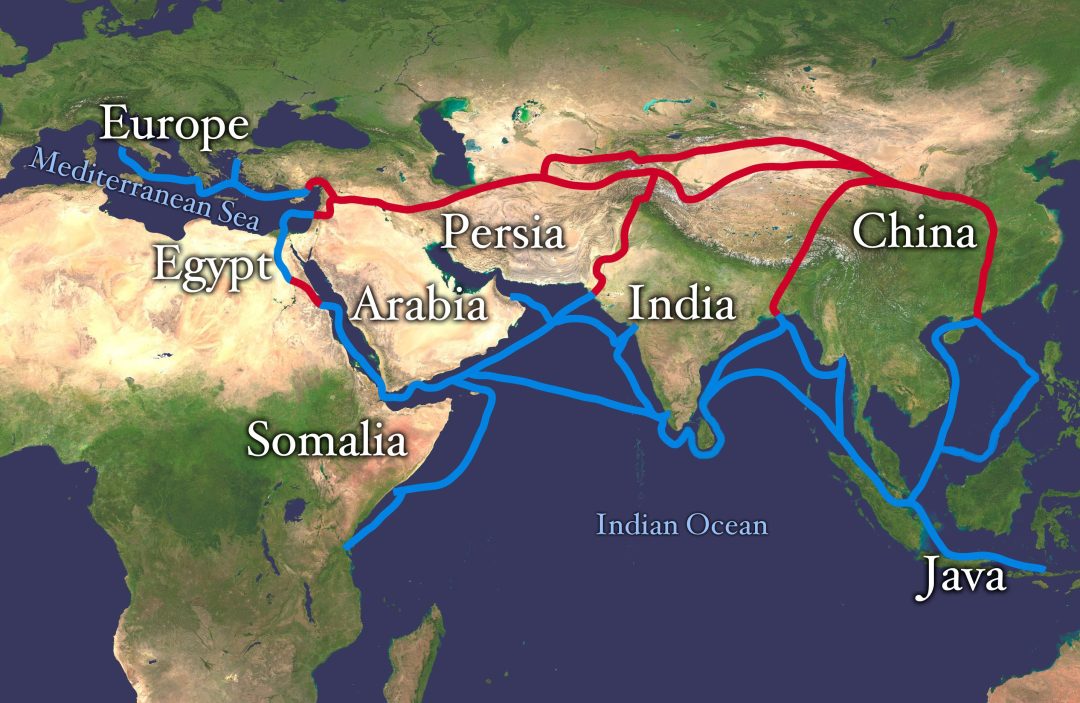Buddhism originated in what is now Nepal around 400 BC. It was founded on the teachings of Siddhartha Gautama, also known as The Buddha (enlightened one).
The Silk Road
The Silk Road, actually a 4,000 mile complex of trade routes linking Europe and the Mediterranean with Central and East Asia, for over 3,000 years served as a commercial, cultural, and technological link between and among the various cultures of the Asia region. There are two main branches of the Silk Road; the East Road transits mostly desert, and the West Road travels over mountainous terrain with peaks over 20,000 feet in places.
The Silk Road earned that name because it was primarily a trade route to facilitate China’s trade of silk with countries to its west, but it was the route by which all other commerce flowed as well. It was, though, more than a mere commercial route. The Silk Road was instrumental in the development of the great civilizations of Asia, such as China, India, Egypt, and Persia. It brought disparate and far flung tribes and clans into the web of commerce and culture, and because of the links with Europe and North Africa, it even impacted the development of western civilization.
Buddhism followed the Silk Road
Buddhism followed the Silk Road from its origin in India, east through Central Asia and to the East, establishing a foothold in Southeast Asia, China, Korea, and Japan. As Buddhism developed, it split into different schools of thought. Theravada Buddhism, which stresses that anyone can achieve the enlightenment of The Buddha and find Nirvana, is strongest in Southeast Asia. Under Theravada Buddhism, there is no concept of a supreme deity, with each individual responsible for his or her fate. Mahayana, or the Greater Vehicle, is a form of Buddhism that elevates Buddha to the status of a deity. Mahayana Buddhism is far more regimented than Theravada, having a hierarchy of priests and monks who are viewed as intermediaries between the individual and the deity.
Monks in Theravada, on the other hand, while revered, are more or less ordinary people who have decided to devote themselves to a life of meditation and contemplation in their search for Nirvana.
Devote lives to the monastery
In Southeast Asia it is common practice for men and boys to devote a period of their lives to the monastery, shaving their heads and donning the saffron robes of a monk, depending upon the generosity of the population for their sustenance. Mahayana religious orders more resemble the hierarchy of western religions, with priesthood being a lifelong calling.
The popularity of the two schools in different regions no doubt reflects the cultural propensity of the particular region. Southeast Asians tend to be easy going and resistant to regimentation, while the societies of East Asia, influenced by Confucianism and Shinto, seem to prefer more order and hierarchy.
The Silk Road served for Buddhism in much the same way western exploration facilitated the spread of Christianity from Europe to the new world. Buddhist monks travel with the great silk caravans, taking the teachings of the Buddha east beginning around the first century AD. Adherents from China also traveled west to India and Nepal to get direct access to the texts of Buddha’s life. Without the Silk Road, Buddhism might well still have spread out over much of Asia, but it probably would have not been as widespread. The Silk Road is but another example of trade, culture, and religion moving together across societies.
https://www.youtube.com/watch?v=pb6vPY20MoE




